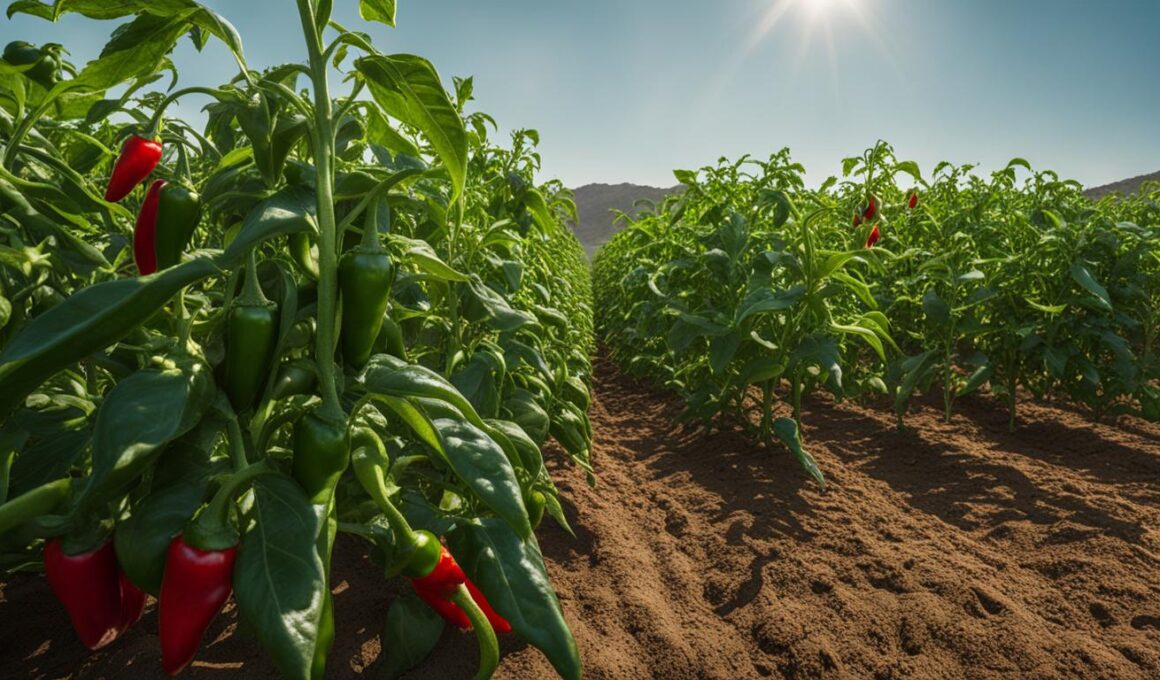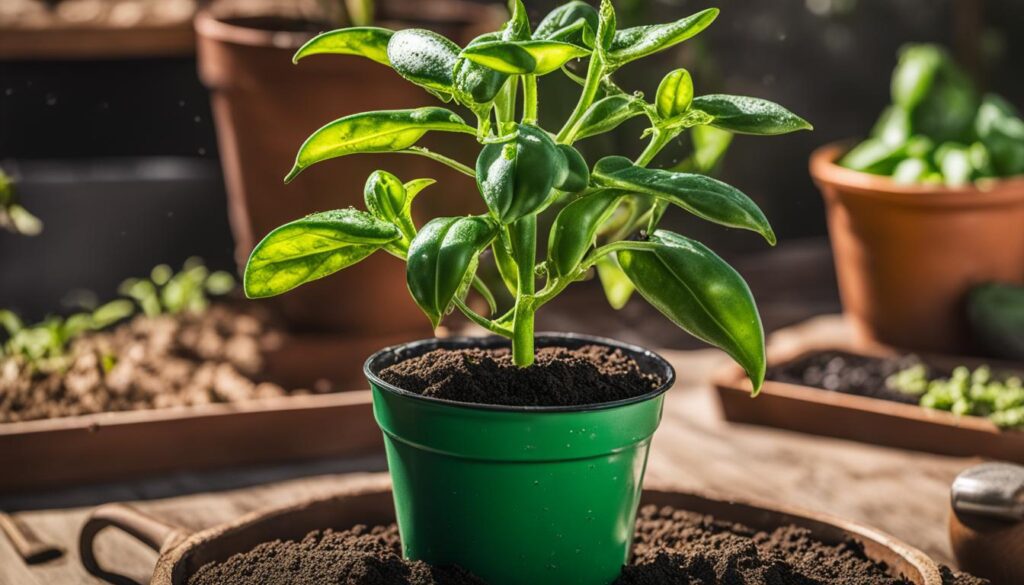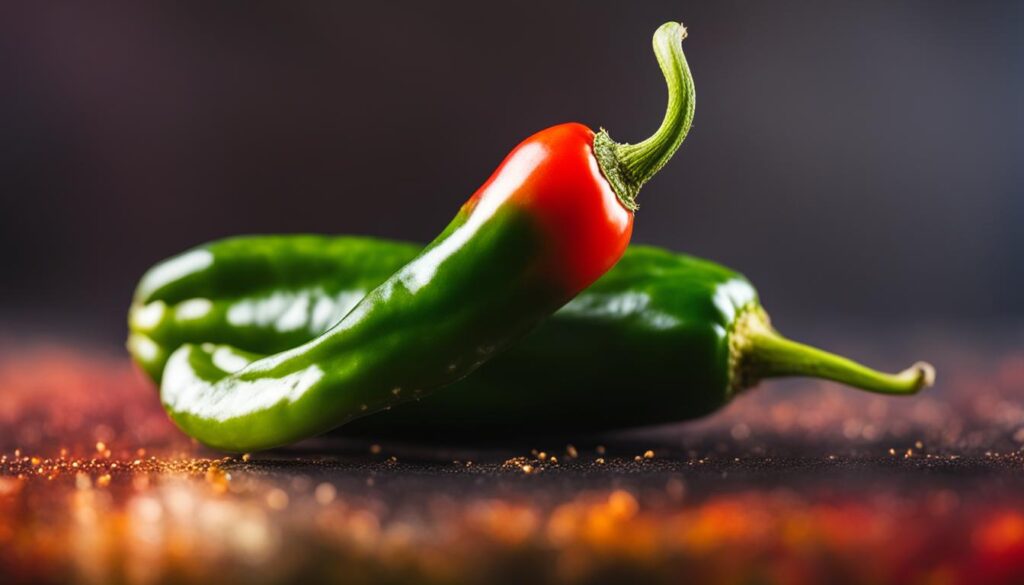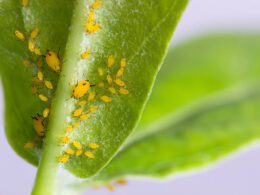Jalapeno peppers, known for their fiery flavor, are sun-loving plants that thrive in full sun conditions. If you’re considering growing jalapenos, it’s important to understand their growing requirements and care tips to ensure hearty and productive plants.
Jalapeno peppers are best grown in a spot that receives at least 6 hours of full sun each day, preferably from 10am to 4pm. They can be cultivated in garden beds or containers, making them adaptable to different environments. When planting in the ground, ensure the soil is well-drained and amended with peat and compost. For container gardening, choose a sturdy container with drainage holes and use a well-draining soil mix.
Consistent moisture is key for jalapeno peppers, so water them when the top inch of soil feels dry to the touch. In hotter weather, they may require daily watering. Fertilize the plants every 2-3 weeks with an all-purpose vegetable fertilizer, especially during flowering and fruiting stages.
Jalapeno peppers are self-pollinating plants, meaning they do not rely on external forces for pollination. They can be harvested at any stage of growth, from green to fully ripened red. The heat level of jalapenos can vary, but they typically fall within the range of 2,500 to 8,000 Scoville Heat Units (SHU).
Post Summary
- Jalapeno peppers thrive in full sun conditions, requiring at least 6 hours of sunlight per day.
- They can be grown in garden beds or containers, but ensure the soil is well-drained.
- Water consistently, keeping the soil evenly moist but not waterlogged.
- Fertilize regularly with an all-purpose vegetable fertilizer.
- Jalapeno peppers are self-pollinating and can be harvested at any stage of growth.
How to Start Growing Jalapenos from Seeds
If you’re interested in growing jalapenos from seeds, you can start the process indoors about 6 weeks before the last frost date. This allows your seedlings to have a head start and be ready for transplanting once the weather warms up.
To begin, plant the jalapeno seeds in well-drained soil, burying them about 1/2 to 1/4 inch deep. Cover the seeds with a light layer of loose, moist soil. It’s important to keep the soil consistently moist and provide humidity for the seedlings. You can achieve this by using a cover until the seedlings reach around 2 inches in height.
As the seedlings grow, gradually introduce them to lower humidity and outdoor conditions. Start by putting them outside for short periods of time and gradually increase the duration each day. This helps the seedlings acclimate to the outdoor environment.
Once all danger of frost has passed and the soil temperature is between 65-80 degrees Fahrenheit, it’s time to transplant your jalapeno seedlings outside. Space the plants at least 12-14 inches apart to allow room for their root systems to spread. If you’re growing in containers, choose a pot that provides enough depth for the roots to develop, similar to the depth needed for a tomato plant.
How to Start Growing Jalapenos from Seeds
Tips for Jalapeno Plant Care
To ensure the health and productivity of your jalapeno plants, proper care is essential. Here are some important tips to keep in mind:
1. Sunlight
Jalapeno plants thrive in full sun conditions, so it’s crucial to provide them with at least 8 hours of sunlight each day. Choose a sunny location in your garden or place them in a spot where they will receive maximum sunlight.
2. Watering
Consistent and even watering is key to maintaining healthy jalapeno plants. Aim to provide about 1 inch of water per week, ensuring that the soil is evenly moist. Avoid overwatering, as it can lead to waterlogged soil and root rot.
3. Soil
Jalapenos prefer well-drained soil with plenty of organic matter. Amend your soil with compost or well-rotted manure to improve its fertility and drainage. This will help the plants grow strong and healthy.
4. Fertilization
Regular fertilization is important for the growth and productivity of jalapeno plants. Use a balanced vegetable fertilizer and apply it every 2-3 weeks, especially during the flowering and fruiting stages. This will provide the necessary nutrients for the plants to thrive.
5. Support
Jalapeno plants can grow quite tall and heavy with peppers, so providing support is essential. Use stakes or cages to help the plants stay upright and support the weight of the peppers. This will prevent the plants from bending or breaking under the weight and ensure healthy growth.
By following these care tips, you can enjoy a bountiful harvest of flavorful jalapeno peppers. Remember to monitor your plants regularly, keep an eye out for pests or diseases, and make adjustments as needed to provide optimal growing conditions.
Harvesting and Storing Jalapeno Peppers
Jalapeno peppers can be harvested at various stages of growth, from green to fully ripened red. The timing of harvest depends on personal preference and the intended use of the peppers. Green jalapenos are typically picked when they are immature and have a slightly bitter taste. Fully ripened jalapenos are bright red in color and have a sweeter flavor. The peppers can also be harvested in the transition stage from green to red for a combination of flavors.
To pick the peppers, snip the stems with scissors or shears to avoid damaging the plant. It’s important to handle the peppers with care, as the oils from the seeds and ribs can cause skin and eye irritation. Wear gloves if necessary and wash your hands thoroughly after handling the peppers.
After harvesting, jalapeno peppers can be stored for 1-2 weeks at 55 degrees Fahrenheit. It’s best to store them in a cool, dry place, away from direct sunlight. Avoid storing them in the refrigerator for long periods, as they are susceptible to chilling injury. If you have a large harvest and want to preserve the peppers for a longer time, you can also freeze them. Simply wash and dry the peppers, remove the stems, and place them in airtight freezer bags or containers. They can be frozen whole or sliced, depending on how you plan to use them later.
| Stage of Harvest | Characteristics | Flavor Profile |
|---|---|---|
| Green (Immature) | Unripe, green color | Slightly bitter, zesty |
| Transition (Green to Red) | Changing color, still partially green | Combination of zesty and sweet |
| Red (Fully Ripened) | Bright red color | Sweeter, more robust flavor |
Remember to always taste a small piece of the pepper before using it in a dish to gauge the heat level. If you prefer milder peppers, remove the seeds and ribs, as they contain the most heat. Enjoy experimenting with the different flavors and heat levels that jalapeno peppers offer!
The Flavor and Uses of Jalapeno Peppers
Jalapeno peppers are known for their unique flavor profile, combining a slight earthiness with a fiery heat. They are a staple in Mexican cuisine and are used to add a zesty kick to a variety of dishes. Green jalapenos have a vibrant and slightly bitter taste, while fully ripened red jalapenos have a robust pepper flavor with a touch of sweetness.
These versatile peppers can be used in a wide range of culinary applications. They are commonly used in salsas, where their heat and flavor complement the other ingredients. You can also add jalapenos to tacos, nachos, quesadillas, and burritos for an extra kick of spice. Their heat can be tempered by removing the seeds and ribs, or by combining them with other ingredients like cheese or avocado.
In addition to their fresh form, jalapenos can be dried and smoked to create chipotle peppers. These peppers have a smoky heat that adds depth and complexity to dishes. Chipotle peppers are often used in adobo sauce, a tangy and slightly sweet sauce that is commonly used in Mexican and Tex-Mex cuisine.
Culinary Uses of Jalapeno Peppers
Here are some popular culinary uses of jalapeno peppers:
- Adding heat and flavor to salsas and dips
- Topping tacos, nachos, and quesadillas for added spice
- Incorporating into marinades and dressings for a zesty kick
- Stuffing with cheese or meat for delicious jalapeno poppers
- Including in soups, stews, and chili for a spicy twist
- Pickling for a tangy and spicy condiment
- Using in sauces, such as hot sauce or adobo sauce
Fun Fact:
“Jalapeno peppers are named after the Mexican city of Jalapa, where they were first cultivated.”
Whether you’re a fan of fiery heat or just enjoy the unique flavor of jalapeno peppers, they are a versatile ingredient that can take your dishes to the next level. So go ahead, experiment with these spicy little peppers and add some excitement to your next meal!
Conclusion
Growing jalapeno peppers can be a rewarding experience for gardeners. By providing full sun, consistent moisture, well-drained soil, and proper care, hearty jalapenos can be successfully grown in gardens or containers.
Harvesting the peppers at different stages of growth allows for a variety of flavors and culinary uses. Whether adding a zesty kick to Mexican dishes or exploring the world of hot chiles, jalapeno peppers are a flavorful addition to any garden and kitchen.
So why not start growing your own jalapenos today? With the right conditions and a little bit of care, you’ll soon be enjoying the spicy, delicious fruits of your labor. Happy gardening!
FAQ
Do jalapeno peppers need full sun?
Yes, jalapeno peppers are sun-loving plants that thrive in full sun conditions. It is recommended to plant or place them in a spot where they will receive at least 6 hours of full sun each day, preferably from 10am to 4pm.
How do I start growing jalapenos from seeds?
To start growing jalapenos from seeds, it is recommended to start them indoors, about 6 weeks before the last frost date. Plant the seeds in well-drained soil, about 1/2 to 1/4 inch deep, and cover with a light layer of loose, moist soil. Keep the soil moist and provide humidity by using a cover until the seedlings reach about 2 inches in height. Gradually introduce the seedlings to lower humidity and outdoor conditions by putting them outside for increasing periods of time each day. Transplant the jalapeno seedlings outside once all danger of frost has passed and the soil temperature is around 65-80 degrees Fahrenheit.
What are some tips for jalapeno plant care?
Proper care is essential for ensuring the health and productivity of jalapeno plants. They require full sun conditions, with at least 8 hours of sunlight each day. The ideal temperature range for jalapenos is between 70-85 degrees Fahrenheit. Water the plants evenly and consistently, aiming for about 1 inch of water per week. Be careful not to overwater, as this can lead to waterlogged soil and root rot. Ensure the soil is well-drained, with lots of organic matter. Fertilize the plants regularly with a balanced vegetable fertilizer, adjusting the fertilizer type according to the growth stage. Provide support for the plants, such as stakes or cages, to help them stay upright and support the weight of the peppers.
How do I harvest and store jalapeno peppers?
Jalapeno peppers can be harvested at various stages of growth, from green to fully ripened red. The timing of harvest depends on personal preference and the intended use of the peppers. Pick the peppers by snipping the stems with scissors or shears to avoid damaging the plant. Store jalapeno peppers for 1-2 weeks at 55 degrees Fahrenheit. Avoid storing them in the refrigerator for long periods, as they are susceptible to chilling injury.
What is the flavor and uses of jalapeno peppers?
Jalapeno peppers have a unique flavor profile that combines a slight earthiness with a spicy kick. They are widely used in Mexican cuisine, adding heat and flavor to dishes such as salsas, tacos, nachos, and more. Green jalapenos have a verdant and astringent taste, with slightly bitter notes beneath the heat. Fully ripened red jalapenos have a robust pepper flavor that is tempered by a lovely sweetness. They can be used in the same way as green jalapenos, providing a different flavor profile. Dried and smoke jalapenos are known as chipotle peppers, which have a smoky heat and are often used in adobo sauce. Jalapeno peppers are versatile and can be incorporated into a variety of savory and sweet applications.
>Can Jalapeno Peppers Thrive with the Same Amount of Water as Other Pepper Plants?
Yes, jalapeno peppers can thrive with the same amount of water as other pepper plants. Understanding the water needs for pepper plants is essential for their growth and productivity. It is important to provide adequate watering to ensure healthy and flavorful jalapenos.










